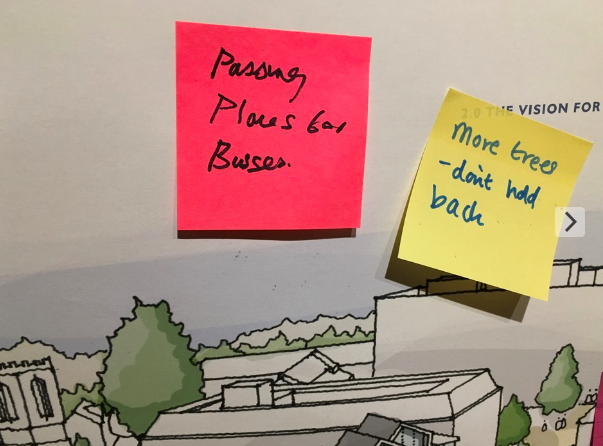
13th February 2019
On 13th February we kicked off Let’s Make Piccadilly with an exploration of cities and green. We did this as a combination of a drop in with walks to Parliament Street to look at the trees and to Ousegate pocket park to look at small green spaces in town.
We were delighted to be joined by Mike Southcombe (Public Protection Manager) and Esther Priestley (Landscape Architect, landscape architects Simon Hall (PWP Design) and Gabrielle Weiss, two councillors and members of The River Foss Society along with 20 or so local residents, local business owners and interested members of the public. (For those interested we’ve done a blog about the format for the events we’re using for Let’s Make Piccadilly).
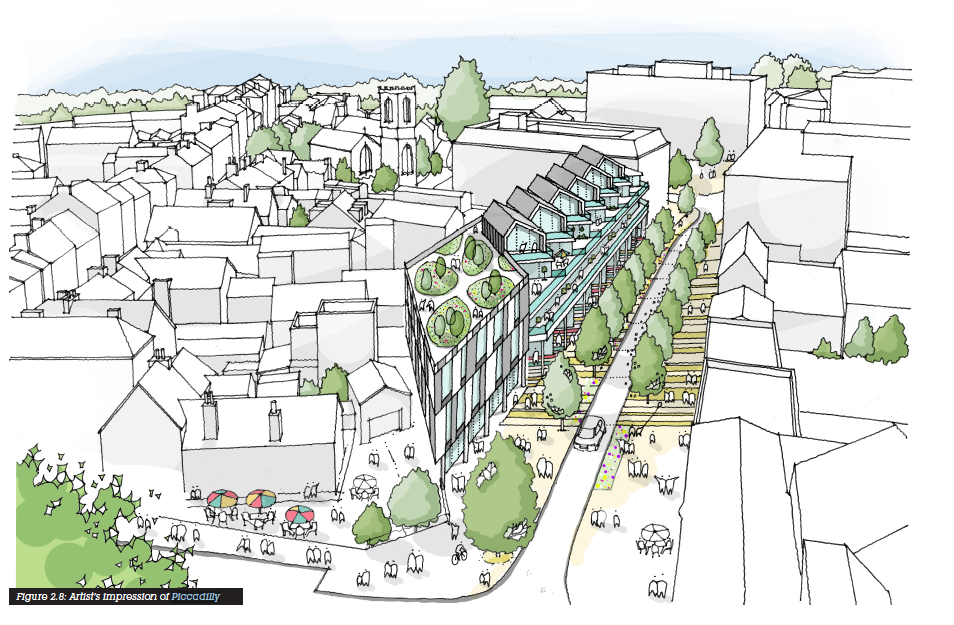
In the Castle Gateway masterplan a key idea is to take back space from the road and to create a wider public space – with around 11m between frontages, a two-way road still allows more than 5m width for pedestrians (and possibly cyclists too). In the image – created just for the purposes of illustration not as a plan – the new pavement space is imagined as a kind of tree-lined boulevard down the straight part of Piccadilly where Spark is now. This image acted as a starting point for most people in the conversation… but the conversations moved on quite quickly.
What type of activities – and how might green help?
To begin the discussions we went back to the kinds of activities people said they’d like to be able to do in the first phase of My Castle Gateway and which informed the masterplan ideas for the street. These included:
- city centre living
- proximity to the historic city centre
- lively atmosphere generated by small and independent businesses including creative industries, workspace, cafés and bars /
- pedestrian friendly avenue of Piccadilly.
- build upon the growing attractions and reputation of Fossgate and Walmgate, as a place to find interesting and independent shops, bars and restaurants
- attract city residents and students as well as visitors looking for an alternative to national ‘high street’ brands and experiences.
We then explored how green enables and enhances these activities – and what kind of green.
Piccadilly is a chance to put pedestrians first – and mean it!
The masterplan is about creating a ‘pedestrian friendly avenue of Piccadilly and lots of people focused on that.
‘pedestrian priority the whole length of the street’
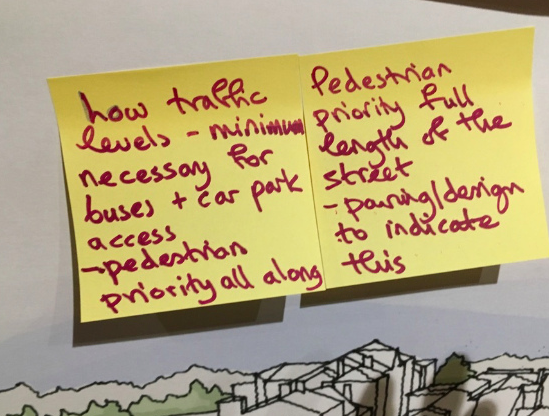
It was asked why the road had to go down the middle? Was there a virtue in having a small pavement on one side and a large one you could do more with on the sunnier side of the street?
What to do about buses? was often raised. How to ensure buses can get into town but also make streets that are nice for pedestrians.
There was also a recognition that drop off points for taxis for the new hotels would be needed – but raised question of how this could be managed without effectively privatising public space.
Make the space feel more human scale
Piccadilly is a 20th century street with an industrial history. One thought was that green and trees would make the street feel more humane and more human scale, like Fossgate and Walmgate.
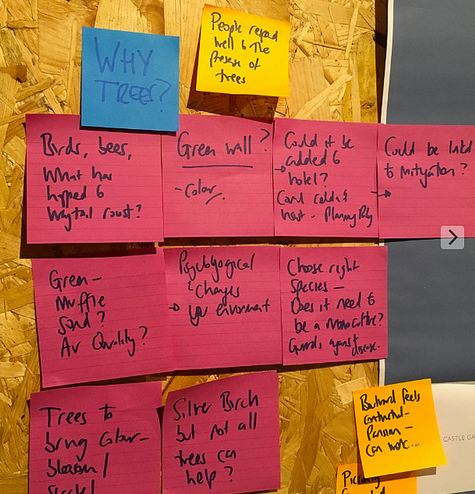
When we started to talk about trees there was an initial thought that they might reduce air pollution and noise but the landscape architects present challenged this. Trees can, apparently, even keep and trap air pollution. However, it was definitely felt that green and trees make a street feel better and more friendly.
‘it’s psychological – it changes the environment’
‘trees bring colour and wildlife’
One issue noted by may was the extent to which the plan should be to disguise and transform as much as possible the characteristics of the 20th century industrial street or whether those characteristics should be embraced. On this there was disagreement but to explore this issue and what it might mean for design, here’s a quote we’ll use in future conversations to develop the brief: ‘Piccadilly is where you have to deal with 20th century York in a positive way’.
Create a sense of meander – the slow down traffic and the eye
The idea of meandering came up in a number of different conversations. For some this was used to literally talk about meandering the street as a way of slowing traffic. A number of people noted that the current “straight road, foot to the floor” nature of Piccadilly encouraged speed, and that perhaps a completely different, more fragmented nature would give different messages to drivers – almost like negotiating public squares which relate to the buildings facing them.
For others this was more about a visual meander, a way of the eye being drawn down the street and to have a variety of different reference points as a way of breaking up the blocky-ness of some of the buildings.
‘trees bring together old and new buildings’
‘trees help make new developments (that can sometime be very inwards facing) more outward facing’
The real potential of such a visual meander became clear when we went for a walk and stood looking down Piccadilly from the end of Parliament Street. The trees already there in the gardens of Merchants Adventurers Hall already immediately draw the eye, if they were complimented with a series of other green points then your eye would be drawn down Piccadilly and give a sense that there were interesting things this around the corner of Piccadilly as it bends.
Break up the street into different spaces for different types of activities and create places that are nice to sit – both outside cafes and on benches
Trees or large-scale planting was also seen as helping to create places where it would be pleasant to sit down. This would by create some sense of intimacy in and otherwise quite open and large-scale space.
It was seen in all of this to make use of the sunny side of the street as much as possible.
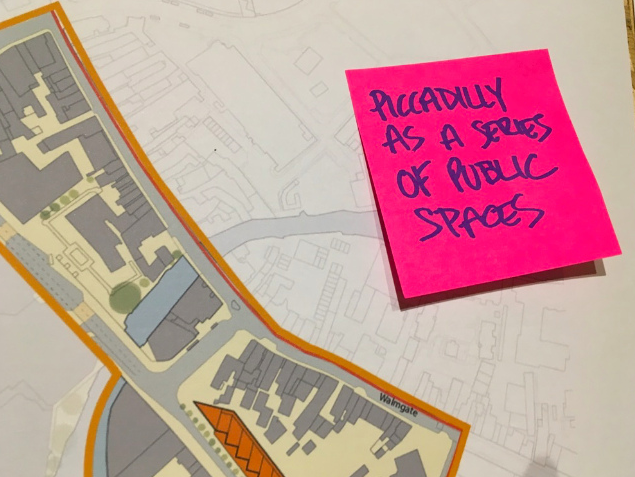
One conversation started to conceptualise Piccadilly as different spaces – almost different rooms – which related to the historic structure of streets leading to the Foss, or to the substantial buildings on either side which command a sense of enclosure, of defining a space.
Where do trees work – and when not and why?
The phrase the ‘right tree in the right place’ was used by many different people – and not just the landscape architects present! The City of York Council Landscape Architect prompted some questions that come up regularly in her work, we then added these to other issues people raised.
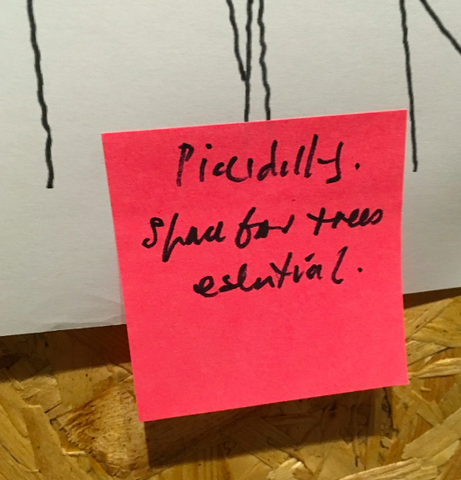
The considerations for trees are:
- size and speed of growth
- type of roots (how this works with the underground services; will they affect the pavement)
- sheading
- maintenance
- shade – but not too much
- native species?
As one person said, in response to the masterplan illustration of Piccadilly: ‘does it need to be a monoculture’ (in terms of tree species)?
Later on in the drop we had some dedicated tree talk with landscape architect Gabrielle Weiss who talked us through possible approaches to trees. Gabrielle really set out the benefits of it not being a monoculture, as this would mean the planting would be less affected by disease; could be different on different sides of the street and suggested a range of native species and species from further afield that might work for Piccadilly.
Some did also ask… ‘does it have to be trees?’ To which the answer from some was ‘yes’! And from others was, ‘maybe not’. With the help of Simon Hall, who design the landscaping for Spark, we talked through the benefits of low maintenance planters like those developed for Spark.
When do small urban public spaces – like Ousegate’s pocket park – work and how can we learn from this on Piccadilly?
One new addition to Piccadilly will be some kind of new space created by the new bridge and route from the new bridge into Piccadilly. To help us reflect on that we visited the Ousegate pocket park. People note some real positives about the space:
‘Close to the street’
‘A good place to people watch’
But there were some issues, the ‘benches don’t look comfortable’; ‘feels a bit grubby’ and was not well maintained: ‘how could it attract children’?
This led to questions of how you can encourage ownership over public space given that the council is unlikely to be able to maintain green space with a lot of planting. One person said ‘it is almost as though you need a friends group for every small green space’.
Thanks to all you came and took part! Here some key issues for us to take forward to the next Let’s Make Piccadilly events:
- How does making a street green relate to making it a good place for pedestrian, cycling and bus travel?
- How can planting help both distinguish between and link public uses and business use?
- How can the green of the Foss be reflected to linked to new greening of Piccadilly?